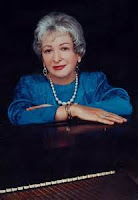 We can create whatever imagery we like in order to help with our illusions—imagination is good—but the fact remains, a hammer hits a wire. That's percussive—not quite on the order of a snare drum, but, well you get the picture. The wire vibrates, which in turn causes the air around it to vibrate sympathetically. This vibrating air is what tickles our ears.
We can create whatever imagery we like in order to help with our illusions—imagination is good—but the fact remains, a hammer hits a wire. That's percussive—not quite on the order of a snare drum, but, well you get the picture. The wire vibrates, which in turn causes the air around it to vibrate sympathetically. This vibrating air is what tickles our ears. A young pianist in a forum once pounced on me for stating that the piano was a percussion instrument. She remarked that I could, if I wanted, have a cadre of carpenters with hammers banging away inside my piano, but she had instead the Mormon Tabernacle choir and the strings of the Philadelphia Orchestra in hers. I thought this was quite funny and a very good description of how imagery can help us shape the quality of the sound we want to hear. Physics be damned.
Some pianists, even distinguished ones—I'm thinking now of Alfred Brendel—feel that by wiggling the finger on the key surface after striking it, a sort of pitched vibrato occurs, a violin-like effect. The hope is, as I understand it, that the sound will have more warmth and perhaps seem more connected to the next pitch. I'm sorry to have to report that only the key wiggles in its bed; the hammer has done its job and moved away. Once the hammer has struck the string, only God can change it, that is, until we release it. Some may argue that it's the intention of the attack that counts. If the key is depressed with the intention of vibrating afterwards, the sound may be affected. This argument seems weak to me.
Side note: Years ago (meaning half a century), I had the opportunity to hear my piano teacher, Muriel Kerr, play the Brahms
C Minor Piano Quartet with Heifetz, Primrose and Piatigorsky. For my younger readers, they were the superstar string players of the 20th century. It was my first time hearing the work, and I was, of course, stunned by its drama and lyricism. Not long after that, I found myself engaged for a
performance of the same piece and, looking at the score for the first time, I noticed that the piano starts with a forte octave tied over two bars with a diminuendo to piano for the entrance of the strings. This diminuendo must take place in tempo, an Allegro non troppo. So I puzzled over how to make a quicker diminuendo. You've probably already guessed the answer.
Inexperienced as I was, though, I had to ask Miss Kerr. She was glad to oblige, and with a giggle, struck the octaves and allowed them to ring for most of the first measure, then released the keys part way and fluttered the pedal for the
remaining three beats, releasing the keys even more. It was a perfect diminuendo from forte to piano in exactly the right amount of time, controlled by the pianist. No need to bother God about it.
Now back to our regularly scheduled topic.
I have written about producing the illusion of legato on the piano by, for example, playing into the decay of each successive note. This is perhaps the closest we can come to the sort of legato a string player can manage, or a singer. Of course, though, this approach produces a pronounced diminuendo, which is not always the desired effect.
My correspondent quotes Samuil Feinberg's book, which "argues that the acoustical illusion of legato has actually more to do with joining together the initial sounds (the immediate sound of the attack), rather than their decay, because if not, he argues, all legato would be diminuendo. And so then, how do you create illusion of legato in a crescendo cantabile line." This is the question we deal with on a daily basis. Feinberg solves this dilemma by "joining the beginnings of each sound, or at least the memory of it."
Exactly right. Music is not a democracy. Every note does not get an equal vote. Feinberg is right. I call this the hierarchy of notes. We must have the musical idea of the line in mind as we play the first note. What are the dynamic relationships? In a lyrical crescendo, each attack of each successive note must be louder in relation to the initial attack of the previous note.
 I think the manner of attack is the most important issue in a moving legato line, that is, play from the key, minimizing downward speed of the key. This removes much of the "attack," but we can still control the dynamic with weight. When Feinberg states that legato is the result of "joining initial sounds," I think he is referring to hierarchy, or put another way, the audible shape of a line. If we take care to control each dynamic ascent in the right relationship to the initial attack of the previous one, controlling the speed of descent into the keybed, a convincing facsimile of legato occurs. Imagine a string of beads in which each bead is graduated from smaller to larger in carefully managed increments.
I think the manner of attack is the most important issue in a moving legato line, that is, play from the key, minimizing downward speed of the key. This removes much of the "attack," but we can still control the dynamic with weight. When Feinberg states that legato is the result of "joining initial sounds," I think he is referring to hierarchy, or put another way, the audible shape of a line. If we take care to control each dynamic ascent in the right relationship to the initial attack of the previous one, controlling the speed of descent into the keybed, a convincing facsimile of legato occurs. Imagine a string of beads in which each bead is graduated from smaller to larger in carefully managed increments.
Some pianists, even distinguished ones—I'm thinking now of Alfred Brendel—feel that by wiggling the finger on the key surface after striking it, a sort of pitched vibrato occurs, a violin-like effect. The hope is, as I understand it, that the sound will have more warmth and perhaps seem more connected to the next pitch. I'm sorry to have to report that only the key wiggles in its bed; the hammer has done its job and moved away. Once the hammer has struck the string, only God can change it, that is, until we release it. Some may argue that it's the intention of the attack that counts. If the key is depressed with the intention of vibrating afterwards, the sound may be affected. This argument seems weak to me.
Side note: Years ago (meaning half a century), I had the opportunity to hear my piano teacher, Muriel Kerr, play the Brahms
 |
| Jascha Heifetz, violin |
 |
| William Primrose, viola |
 |
| Gregor Piatigorsky, cello |
 |
| Muriel Kerr, piano |
Now back to our regularly scheduled topic.
I have written about producing the illusion of legato on the piano by, for example, playing into the decay of each successive note. This is perhaps the closest we can come to the sort of legato a string player can manage, or a singer. Of course, though, this approach produces a pronounced diminuendo, which is not always the desired effect.
My correspondent quotes Samuil Feinberg's book, which "argues that the acoustical illusion of legato has actually more to do with joining together the initial sounds (the immediate sound of the attack), rather than their decay, because if not, he argues, all legato would be diminuendo. And so then, how do you create illusion of legato in a crescendo cantabile line." This is the question we deal with on a daily basis. Feinberg solves this dilemma by "joining the beginnings of each sound, or at least the memory of it."
Exactly right. Music is not a democracy. Every note does not get an equal vote. Feinberg is right. I call this the hierarchy of notes. We must have the musical idea of the line in mind as we play the first note. What are the dynamic relationships? In a lyrical crescendo, each attack of each successive note must be louder in relation to the initial attack of the previous note.
 I think the manner of attack is the most important issue in a moving legato line, that is, play from the key, minimizing downward speed of the key. This removes much of the "attack," but we can still control the dynamic with weight. When Feinberg states that legato is the result of "joining initial sounds," I think he is referring to hierarchy, or put another way, the audible shape of a line. If we take care to control each dynamic ascent in the right relationship to the initial attack of the previous one, controlling the speed of descent into the keybed, a convincing facsimile of legato occurs. Imagine a string of beads in which each bead is graduated from smaller to larger in carefully managed increments.
I think the manner of attack is the most important issue in a moving legato line, that is, play from the key, minimizing downward speed of the key. This removes much of the "attack," but we can still control the dynamic with weight. When Feinberg states that legato is the result of "joining initial sounds," I think he is referring to hierarchy, or put another way, the audible shape of a line. If we take care to control each dynamic ascent in the right relationship to the initial attack of the previous one, controlling the speed of descent into the keybed, a convincing facsimile of legato occurs. Imagine a string of beads in which each bead is graduated from smaller to larger in carefully managed increments.




















